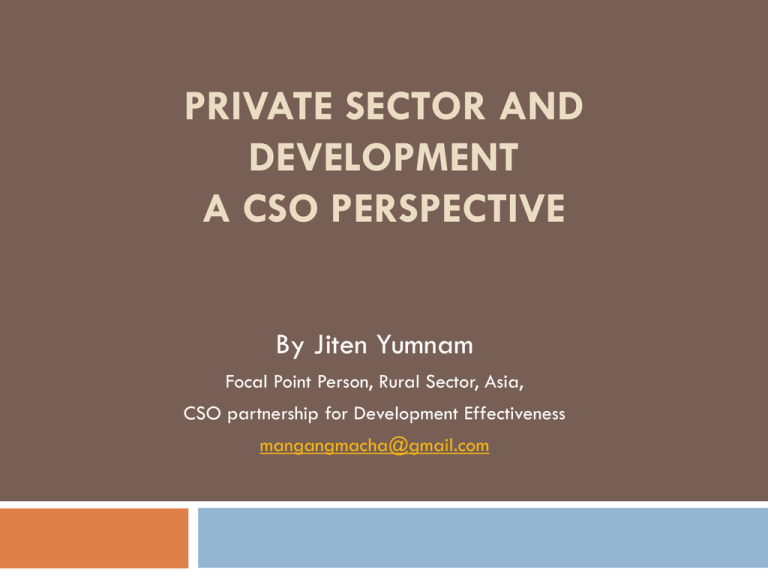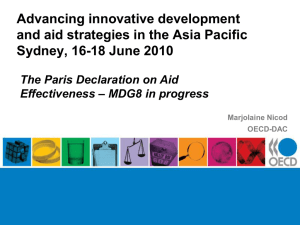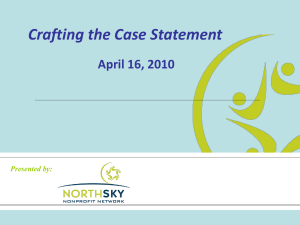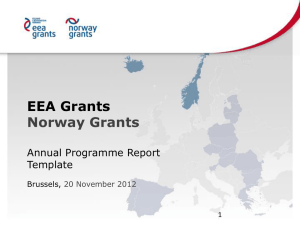Partnerships with business - CSO views
advertisement

PRIVATE SECTOR AND DEVELOPMENT A CSO PERSPECTIVE By Jiten Yumnam Focal Point Person, Rural Sector, Asia, CSO partnership for Development Effectiveness mangangmacha@gmail.com Increasing Emphasis on private sector and partners of development “We recognize the central role of the private sector in advancing innovation, creating wealth, income and jobs, mobilizing domestic resources and in turn contributing to poverty reduction” - Busan Partnership for Effective Development Cooperation (BPd) – Fourth High Level Forum, Busan, November 2011. Increasing Emphasis on Private Sector as partners of development OECD-Development Assistance Committee (DAC) emphasized on the private sector as key for development. OECD launched its Principles for Private Sector Participation in infrastructure in 2007. Multilateral Banks, Bilateral Donors emphasizing on private sector led economic growth and development. WTO, DFIs, Donors, Government creating enabling environment for Private Sector Public Private Partnerships There is overwhelming focus on PPP model of development. Most PPP projects followed Build-Own-Operate) model with the private sector running the project There’s a larger trend of neglecting the social infrastructure in PPPs. Private sectors, with high profit motives, often favours development of roads, railways, ports and electricity etc, as user fees charging is more feasible. And such projects have a market that combines construction with the provision of related services, viz, operation of toll road), than social infrastructure projects, viz, health and education. There’s limited regulatory framework to ensure PPP operation promote democratic ownership, effectiveness and accountability. DFI’s and Private sector promotion A primary bilateral donor engagement with the private sector has been through Development Finance Institutions (DFIs), such as World Bank’s International Finance Corporation, or bilateral development finance agencies. Investments to the private sector by international financial institutions (IFIs) crossed US$40 billion In 2010 and expected to exceed US$100 billion by 2015. In Belgium, donor investment in private sector development grew from 44.6 million in 2008 to 123.6 million in 2011, almost exclusively through BIO-Invest, the Belgian DFI. Enabling Environment for Private Sector Participation – Role of Government Goverment’s Policy Formulations for Public Private Partnerships (Bangladesh - “Draft of PPP Policy” in 2011. Mexico - Public-Private Partnerships legislation. New policies to facilitate land for corporate bodies (India - Land Acquisition Act, 2013). Inconsistent application of law and safeguards. Series of policy reforms Policy deregulations, such as weakening of environment laws such as on EIAs/SIAs to protect communities rights and to ensure their rightful participation in decision making (Amendments on EIA Notification, 1993) Reluctance to implement Int’l Human rights standards that can promote democratic ownership (UN Declaration on Indigenous Peoples Rights, 2007) Protection for corporate bodies (private security forces, militarization etc), inaction on violations by corporations. Allowing FDIs, subsidies, Tax reforms, policy changes etc Enabling Environment for Private Sector Led Development – Role of IFIs – India Privatisation and private sector participation pursued vigorously through Structural Adjustment Programmes and Country Strategic Plans of IFIs In June 1991, India launched first comprehensive economic policy reform program, which the World Bank supported with a $500 million structural adjustment operation (SAL), approved in December 1991 till 1993. India has taken up following measures to implement SAP : New Industrial Policy allowing more foreign investments., Opening up more areas for private domestic and foreign investment, Part disinvestment of government equity in profitable public sector enterprises., Sick public sector units to be closed down., Reforms of the financial sector by allowing in private banks., Liberal import and export policy, Cuts in social sector spending to reduce fiscal deficit, Amendments to the existing laws and regulations to support reforms, Market approach and less government intervention, Liberalization of the banking system, Tax reform The budget of 1994-95, of which health care forms just 0.58% is an indication of the government willingness to adopt Bank's policies. Private Sector and Development – Priority Setting and Improving Coherence: The private sector is indeed a major actor for creating economic opportunities for people living in poverty, through investment, generating employment, creating innovation and generating revenue for social sectors. But not all such investment has an impact on poverty and growing socio-economic inequalities in many countries experiencing strong economic growth. In many cases, there are adverse realities and impacts with private sector. Private Sector and Key Aid Effectiveness Principles Private sector involvement in development can be more effective as development actor by improving its performance on promoting democratic ownership and human rights. Private sector involvement in development is afflicted with human rights challenges across Asia Pacific region, ranging from exclusive decision making, mis prioritization, misinformation, limited impacts appraisal impacts, lack of accountability etc and cases abound. The development principles of private sector, i.e to seek profit and associated practice is often incompatible with the development priorities of many marginalized communities and which maintained inseparable relationship with their land for survival, and this impinge on development results Specific Cases of human rights challenges in private sector involvement in development Lafarge Limestone Mining funded by World Bank and Asian Development Bank in Meghalaya, India’s NE Mega Dams construction in India’s North East WB’ Road project, JBIC’s Tuirial HEP Project in Mizoram The liquefied natural gas project, financed by the Australian Government’s Export Finance and Insurance Corporation in Papua New Guinea Mining in Cordillera and West Papua (Mining increased concentration of economic wealth, conflicts with indigenous people over land rights) Displacements in mining in Orissa, SEZs, Ports etc. Water Privatisation in India Water privatization has been emphasized by the Government of India’s National water policy (National Water, 2002) to address the issue of water scarcity and for planning, development and management of water resources. Most of the privatization in India follows the BOOT model. The Pilot water privatisation in Mumbai led to price hike and inaccessibility of water service by many of the marginalized and poor, such as the slum dwellers. The national water policy also encourages interlinking of rivers to improve water availability in water scarce areas (interlinking, 2005). The proposed river linking scheme has water privatization at its heart of funding, which will further isolate the water source and responsible water management from local communities. Communities questioned the merits of such a scheme on numerous grounds including lack of consultation, absence of impact assessment, ecological disasters from river diversion schemes around the world, as well as adverse environmental impact due to submergence soil salinity and water logging. Power Sector privatisation in India and challenges The privatisation of power sector of New Delhi led to steep rise in tariffs. This is in spite of a 328% increase of tariffs for domestic consumers after privatisation – Rs 1.37 per unit in 2002 to Rs 5.87 per unit in 2013. The Comptroller and Auditor General of India report had stated that the assets of Delhi Vidyut Board were undervalued by a whopping Rs 3,107 crores! In addition, the Delhi government paid the private companies 10 times more as subsidy – 3,500 crore – than what they brought in as equity. Private sector and Food sovereignty: - - - Involvement of private Agri-business companies in agriculture had already led to wide adverse impacts on small scale farmers across Asia, such as high farmers massive suicides among farmers in India. At the 2012 G8 Summit, USA launched the “New Alliance to Increase Food and Nutrition Security”, for partnerships with the private sector to focus their non-aid resources for smallholder producers. President Obama announced the participation of 45 companies in the Alliance, including agribusiness companies such as Cargill, DuPont and Monsanto, and committed US$3 billion. An assessment of global food crisis, impacts of private sector involvement in agriculture in developing countries should precede any decision for emphasizing on private sector in Agriculture. Challenge – Private Sector Increasing Disparity between Rich and Poor: Increased private sector involvement in development processes is also associated with increasing disparity and widening inequality among the rich and the poor in many countries across Asia and Pacific. Donors’ promotion of privatization has increased the price of basic services such as water, electricity, health, education etc. Private sector engagement in development is seemingly not stimulating pro-poor growth and hence needs introspection to bridge the gap between the gap between rich and poor. Private sector participation & challenges Private sector involvement in development will be more effective if the Donors, DFIs, and Governments ensure enabling environments are more geared towards upholding development rights of marginalized communities and according due sensitivity to the survival rights. Many donors still need to fulfil commitments to human rights and aid effectiveness principles into their private sector strategies. As development standards progress, private sectors’ human rights commitments and implementation also need to keep similar pace. Many corporate bodies and bilateral donors are yet to adopt the UN Declaration on the Rights of Indigenous Peoples, 2007 and to recognize their inherent right to Free, Prior and Informed Consent despite their operations in indigenous peoples land and territories. Enabling Environment Donors and Private Sector Participation With most donors insisting on supporting their own corporations, it difficult to reconcile corporate private sector interests with achieving development goals. There is a clear rule that Finnfund must support “Finnish interest”, first which meant creating commercial benefits for Finnish business. AusAID indeed launched its AUS$127 million Australian Mining for Development Initiative (AMDI) in October 2011 with the official aim of promoting “sustainable mining” in developing countries. Can there be real poverty reduction by focussing on benefits of corporations in developed countries, and not by empowering private sector and informal economies in developing countries. Key challenges with Bilateral Donors Inclusive development priority setting and holistic impact assessment process very limited. Absence of Information disclosure Non integration of Accountability mechanism Limited integration of social safeguard mechanism Relinquish responsibility while emphasizing on country system Not keeping pace with advances on HRBA/IP rights (JBIC has no plan on Indigenous Peoples) Key Challenges with IFIs The IFI’s funding creates enabling environment for the private sector and not so much for communities and environment Priority setting often exclusive, Emphasizing on consultations as against consent, inadequate Impact assessment The High Voltage transmission lines across India’s North East and GMs countries, funded by ADB and World Bank only encouraged mega dams constructions by private parties, which again sought additional profits from CDM mechanism without informing affected peoples. Challenge with information & accountability for violations, inaccessibility , limitation of accountability mechanism of IFIs Way forward – Private Sector and Development For private sectors to be a true partners in development, they must collaborate in ways that improve the social and economic rights of marginalized populations, focus on the economic empowerment of women, create conditions for decent work, and fund to promote socio-economic inclusion and social protection. Private sector can only contribute in development if it maintains country ownership and bring effective development result for the vulnerable populations. Way Forward – Private Sector and Development Defining development priorities should not just be exclusive domain of the private sector, the donors and the DFI’s etc., but should ensure the rightful participation and involvement of communities Private sector tends to insist on short term measures for quick profits. However, development needs a long term intervention. For example ‘poverty reduction’ is a long-term process and the success of response depends on many factors, such as political turmoil, natural calamity, literacy, economic policies etc. Securing check and balances to ensure compliance to best development standards oriented toward peoples’ and ecological rights is crucial. Way Forward – Private Sector and Development Restore donor commitments to increase ODA resources dedicated to poverty eradication and reducing inequality. Ensure that aidsupported private sector investments, private sector development give priority to the local private sector and social economy consistent with aid effectiveness principles and commitments Under Busan Partnership and Action for Development Cooperation. Corporations, which invest in developing countries, should promote human rights under existing international human rights laws and should not collude in human rights violations by the partner country government, such as forced evictions or forced labour. All Government should issue enforceable human rights and environmental guidelines for corporations and monitor their compliance with rightful participation of the civil society from the developing country. Way Forward – Private Sector and Development International Financial Institutions, Bilateral donors should ensure formulation and compliance of social, environmental and human rights safeguards for their investment in private sector and in project implementation, in accordance with prevailing development best practice standards. Bilateral donors also need to formulate social, environment and human rights safeguards. Way Forward – Private Sector and Development Implement the ILO Decent Work Agenda and apply ILO core labour standards in the implementation of aidsupported private sector investments and sector development initiatives, the OECD Guidelines for Multinational Enterprises. Put transparency and accountability at the heart of all private sector engagement and development. Full public access to all project documentation and affected populations to have a rightful voice and hold private sector actors accountable to development results. Companies should report on their financial affairs, including tax and procurement procedures, on a country basis. Way forward – Private Sector and Development Definition of Alternatives is something missing out. Alternatives to development with community participation can promote development which can minimize impact on people and environment and can indeed also offer solutions for sustainable development. Way Forward – Private Sector and Development End formal and informal tying of aid and aid-supported investments. Ensure public procurement respect public policy goals to strengthen local capacities in developing countries Country ownership, Democratic and inclusive ownership of development should be supported Corporations, involved in developing countries, should elaborate a code of conduct for their role in development projects and follow these standards irrespective of the laws of the country concerned. All corporations, involved in developing countries, should carry out a fair and transparent Environmental and Social Impact Assessment before the development project is launched. Thagatchari THANK YOU






